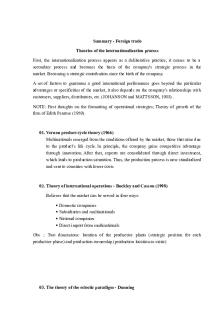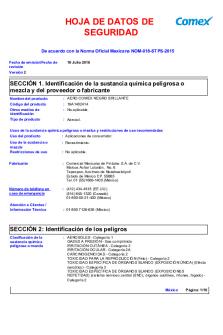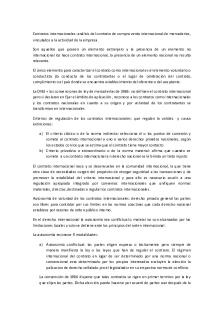Summary comex PDF

| Title | Summary comex |
|---|---|
| Author | Vitor Malheiros |
| Course | Relações internacionais |
| Institution | Universidade da Amazônia |
| Pages | 3 |
| File Size | 88.9 KB |
| File Type | |
| Total Downloads | 63 |
| Total Views | 140 |
Summary
class notes about summary comex...
Description
Summary - Foreign trade Theories of the internationalization process First, the internationalization process appears as a deliberative practice, it ceases to be a secondary process and becomes the basis of the company's strategic process in the market. Becoming a strategic contribution since the birth of the company. A set of factors to guarantee a good international performance goes beyond the particular advantages or specificities of the market, it also depends on the company's relationships with customers, suppliers, distributors, etc. (JOHANSON and MATTSSON, 1988) . NOTE: First thoughts on the formatting of operational strategies; Theory of growth of the firm of Edith Penrose (1959).
01. Vernon product cycle theory (1966) Multinationals emerged from the conditions offered by the market, those that arise due to the product's life cycle. In principle, the company gains competitive advantage through innovation. After that, exports are consolidated through direct investment, which leads to production saturation. Thus, the production process is now standardized and sent to countries with lower costs.
02. Theory of international operations - Buckley and Casson (1998) Believes that the market can be served in four ways: Domestic companies Subsidiaries and multinationals National companies Direct import from multinationals Obs .: Two dimensions: location of the productive plants (strategic position for each productive phase) and production ownership (production location as static)
03. The theory of the eclectic paradigm - Dunning
The model involves determinants of international production. This paradigm seeks to explain the patterns of internationalization through three variables: Ownership (property advantage): technology, human resources, patents, information, brands, etc. Localization: advantage that can be developed by the company itself considering the aspects of each country. Like infrastructure, labor, etc. Internalization: the organization's ability to internalize advantages of properties acquired in foreign markets. 04. The
internationalization
process
according
to
the
Nordic
school
in
Uppsala. Johanson and Vahlne (1977) Model based on empirical observations (small steps) Gradualism as a means of studying the empirical field of international performance 4.1 Internships: 1. Sporadic exports not regular 2. Exports through independent representatives 3. Direct exports 4. Commercial implementation in the foreign country Obs .: cultural and linguistic factors hinder communication and the development of the relationship with the client. 4.2 Concepts for planning the internationalization process (organizational learning) Market knowledge Commitment to the market Commitment decision Current activities
5.
Innovation model - Reid (1981) and Czinkota and Johnston (1985) Internationalization through innovation Internationalization is a sequential organizational learning plan through the implementation of new strategies Characterized by resources
the gradual
and
incremental application of
Takes into account the personal characteristics of the executives 6.
The distance psychic and interaction buyer / seller - Hallen and
Wiedersheim- Paul. (1979) There is a mental and geographic distance between the selling company and buyer of different countries Psychic positioning must be taken into account To establish a business relationship Concept of psychic distance : developed by the Nordic School of International Business. Guiding principles: level of development and education of the country, business practices and language....
Similar Free PDFs

Summary comex
- 3 Pages

Resumen 1ER Parcial Comex
- 12 Pages

Comex- Sellador- Silicon
- 3 Pages

03. HDS AERO Comex Negro Brillante
- 16 Pages

Plan de estudios unlam comex
- 1 Pages

Investigación de la empresa Comex
- 13 Pages

02. FT- Comex- Thinner- Estandar
- 2 Pages

02. HDS- Thinner Estandar EPH Comex
- 15 Pages

Summary
- 4 Pages

Summary
- 42 Pages

Summary
- 43 Pages

- Summary
- 41 Pages

Summary
- 56 Pages
Popular Institutions
- Tinajero National High School - Annex
- Politeknik Caltex Riau
- Yokohama City University
- SGT University
- University of Al-Qadisiyah
- Divine Word College of Vigan
- Techniek College Rotterdam
- Universidade de Santiago
- Universiti Teknologi MARA Cawangan Johor Kampus Pasir Gudang
- Poltekkes Kemenkes Yogyakarta
- Baguio City National High School
- Colegio san marcos
- preparatoria uno
- Centro de Bachillerato Tecnológico Industrial y de Servicios No. 107
- Dalian Maritime University
- Quang Trung Secondary School
- Colegio Tecnológico en Informática
- Corporación Regional de Educación Superior
- Grupo CEDVA
- Dar Al Uloom University
- Centro de Estudios Preuniversitarios de la Universidad Nacional de Ingeniería
- 上智大学
- Aakash International School, Nuna Majara
- San Felipe Neri Catholic School
- Kang Chiao International School - New Taipei City
- Misamis Occidental National High School
- Institución Educativa Escuela Normal Juan Ladrilleros
- Kolehiyo ng Pantukan
- Batanes State College
- Instituto Continental
- Sekolah Menengah Kejuruan Kesehatan Kaltara (Tarakan)
- Colegio de La Inmaculada Concepcion - Cebu


